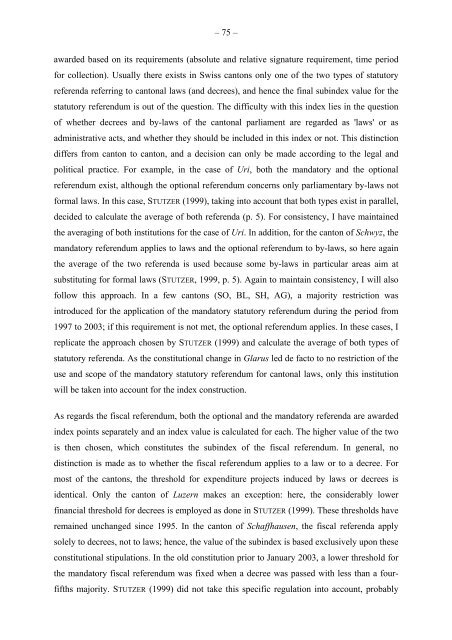The Impact of Direct Democracy on Society - Universität St.Gallen
The Impact of Direct Democracy on Society - Universität St.Gallen
The Impact of Direct Democracy on Society - Universität St.Gallen
- No tags were found...
Create successful ePaper yourself
Turn your PDF publications into a flip-book with our unique Google optimized e-Paper software.
– 75 –awarded based <strong>on</strong> its requirements (absolute and relative signature requirement, time periodfor collecti<strong>on</strong>). Usually there exists in Swiss cant<strong>on</strong>s <strong>on</strong>ly <strong>on</strong>e <str<strong>on</strong>g>of</str<strong>on</strong>g> the two types <str<strong>on</strong>g>of</str<strong>on</strong>g> statutoryreferenda referring to cant<strong>on</strong>al laws (and decrees), and hence the final subindex value for thestatutory referendum is out <str<strong>on</strong>g>of</str<strong>on</strong>g> the questi<strong>on</strong>. <str<strong>on</strong>g>The</str<strong>on</strong>g> difficulty with this index lies in the questi<strong>on</strong><str<strong>on</strong>g>of</str<strong>on</strong>g> whether decrees and by-laws <str<strong>on</strong>g>of</str<strong>on</strong>g> the cant<strong>on</strong>al parliament are regarded as 'laws' or asadministrative acts, and whether they should be included in this index or not. This distincti<strong>on</strong>differs from cant<strong>on</strong> to cant<strong>on</strong>, and a decisi<strong>on</strong> can <strong>on</strong>ly be made according to the legal andpolitical practice. For example, in the case <str<strong>on</strong>g>of</str<strong>on</strong>g> Uri, both the mandatory and the opti<strong>on</strong>alreferendum exist, although the opti<strong>on</strong>al referendum c<strong>on</strong>cerns <strong>on</strong>ly parliamentary by-laws notformal laws. In this case, STUTZER (1999), taking into account that both types exist in parallel,decided to calculate the average <str<strong>on</strong>g>of</str<strong>on</strong>g> both referenda (p. 5). For c<strong>on</strong>sistency, I have maintainedthe averaging <str<strong>on</strong>g>of</str<strong>on</strong>g> both instituti<strong>on</strong>s for the case <str<strong>on</strong>g>of</str<strong>on</strong>g> Uri. In additi<strong>on</strong>, for the cant<strong>on</strong> <str<strong>on</strong>g>of</str<strong>on</strong>g> Schwyz, themandatory referendum applies to laws and the opti<strong>on</strong>al referendum to by-laws, so here againthe average <str<strong>on</strong>g>of</str<strong>on</strong>g> the two referenda is used because some by-laws in particular areas aim atsubstituting for formal laws (STUTZER, 1999, p. 5). Again to maintain c<strong>on</strong>sistency, I will als<str<strong>on</strong>g>of</str<strong>on</strong>g>ollow this approach. In a few cant<strong>on</strong>s (SO, BL, SH, AG), a majority restricti<strong>on</strong> wasintroduced for the applicati<strong>on</strong> <str<strong>on</strong>g>of</str<strong>on</strong>g> the mandatory statutory referendum during the period from1997 to 2003; if this requirement is not met, the opti<strong>on</strong>al referendum applies. In these cases, Ireplicate the approach chosen by STUTZER (1999) and calculate the average <str<strong>on</strong>g>of</str<strong>on</strong>g> both types <str<strong>on</strong>g>of</str<strong>on</strong>g>statutory referenda. As the c<strong>on</strong>stituti<strong>on</strong>al change in Glarus led de facto to no restricti<strong>on</strong> <str<strong>on</strong>g>of</str<strong>on</strong>g> theuse and scope <str<strong>on</strong>g>of</str<strong>on</strong>g> the mandatory statutory referendum for cant<strong>on</strong>al laws, <strong>on</strong>ly this instituti<strong>on</strong>will be taken into account for the index c<strong>on</strong>structi<strong>on</strong>.As regards the fiscal referendum, both the opti<strong>on</strong>al and the mandatory referenda are awardedindex points separately and an index value is calculated for each. <str<strong>on</strong>g>The</str<strong>on</strong>g> higher value <str<strong>on</strong>g>of</str<strong>on</strong>g> the twois then chosen, which c<strong>on</strong>stitutes the subindex <str<strong>on</strong>g>of</str<strong>on</strong>g> the fiscal referendum. In general, nodistincti<strong>on</strong> is made as to whether the fiscal referendum applies to a law or to a decree. Formost <str<strong>on</strong>g>of</str<strong>on</strong>g> the cant<strong>on</strong>s, the threshold for expenditure projects induced by laws or decrees isidentical. Only the cant<strong>on</strong> <str<strong>on</strong>g>of</str<strong>on</strong>g> Luzern makes an excepti<strong>on</strong>: here, the c<strong>on</strong>siderably lowerfinancial threshold for decrees is employed as d<strong>on</strong>e in STUTZER (1999). <str<strong>on</strong>g>The</str<strong>on</strong>g>se thresholds haveremained unchanged since 1995. In the cant<strong>on</strong> <str<strong>on</strong>g>of</str<strong>on</strong>g> Schaffhausen, the fiscal referenda applysolely to decrees, not to laws; hence, the value <str<strong>on</strong>g>of</str<strong>on</strong>g> the subindex is based exclusively up<strong>on</strong> thesec<strong>on</strong>stituti<strong>on</strong>al stipulati<strong>on</strong>s. In the old c<strong>on</strong>stituti<strong>on</strong> prior to January 2003, a lower threshold forthe mandatory fiscal referendum was fixed when a decree was passed with less than a fourfifthsmajority. STUTZER (1999) did not take this specific regulati<strong>on</strong> into account, probably
















